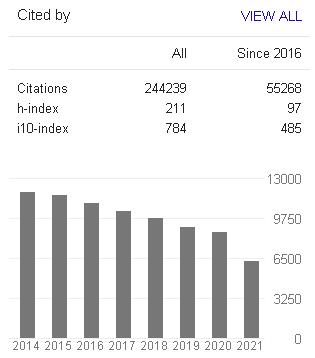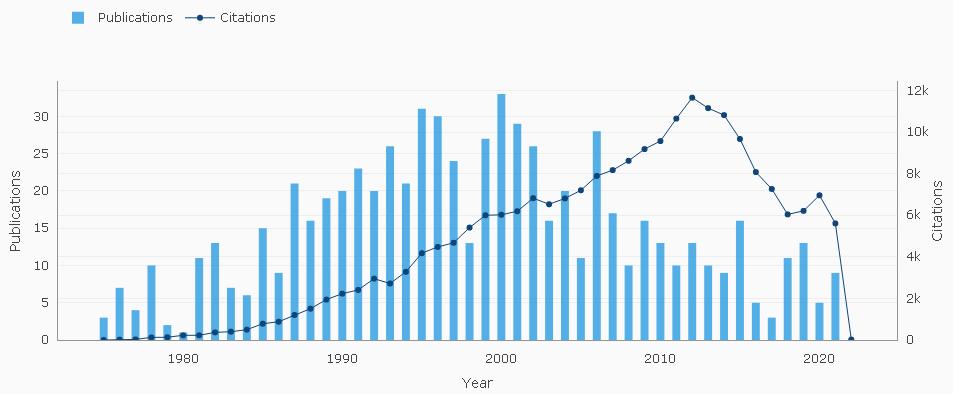博文
巴里·哈利韦尔:2021年化学引文桂冠奖获得者之一
||
巴里·哈利韦尔:2021年化学引文桂冠奖获得者之一
诸平
新加坡国立大学(National University of Singapore简称NUS)的巴里·哈利韦尔(Barry Halliwell)是科睿唯安(Clarivate)2021年3位化学引文桂冠奖获得者(Citation Laureates 2021/Chemistry)之一。获奖原因是在自由基化学方面的开创性研究,包括自由基和抗氧化剂在人类疾病中的作用。本文对其进行简要介绍,仅供参考。
1 简介
巴里·哈利韦尔(Barry Halliwell)是英国生物化学家,化学家和大学管理者,专门研究动植物的自由基代谢。 1949年10月18日生于英国兰开夏郡普雷斯顿(Preston, Lancashire)的巴里·哈利韦尔,早年曾就读于普雷斯顿文法学校(Preston Grammar School),1968年考入牛津大学圣凯瑟琳学院(St Catherine's College, University of Oxford)学习,1971年获得生物化学一级荣誉学士学位(BA with First Class (honours) in biochemistry)。他还因在生物科学领域的最佳论文而获得了玫瑰奖(Rose Prize)。在获得生物化学学术学位之后,1971年又在牛津大学攻读植物生物化学博士学位,在弗雷德里克·R·沃特利(Frederick R. Whatley)和弗农·巴特(Vernon Butt)指导下,以《植物过氧化物酶体的生物化学》(The biochemistry of plant peroxisomes) 为题的博士论文,使其于1973年顺利通过获得牛津大学的博士学位。1973年牛津大学博士毕业后,巴里·哈利韦尔在朴次茅斯理工学院(Portsmouth Polytechnic)做过短暂的演讲(到1974年)。1974年,他在伦敦国王学院(King's College London)担任讲师,直到2000年,在药理学部门(Division of Pharmacology)担任医学生物化学教授。1974-2000年,他在伦敦国王学院任教,并获得了著名的李斯特研究所研究员(Lister Institute Research Fellowship)。
在1986年全年(1986-01-01—1986-12-31),巴里·哈利韦尔在英国伦敦大学(University of London),因在植物和动物系统中的自由基反应的生物化学方面的工作——“动植物系统中自由基反应的生物化学(The Biochemistry of Free Radical Reactions in Animal and Plant Systems)”,而获得了伦敦大学(University of London)的理学生物化学博士学位(D.Sc, Biochemistry)。
在1995-1999年期间,巴里·哈利韦尔还同时在美国加州大学戴维斯分校(University of California, Davis, United States)医学院心脏病学和肺病/重症监护医学系的内科和生物化学客座研究教授(Visiting Research Professor of Internal Medicine and Biochemistry with the University of California Davis, School of Medicine, Divisions of Cardiology and Pulmonary/Critical Care Medicine)。特别是1998年,巴里·哈利韦尔在NUS度假后,他于2000年入职NUS,并担任生物化学系主任一直到2007年。
2001-2003年任生命科学办公室副主任(Deputy Director, Office of Life Sciences)。2003-2008年9月,担任NUS综合科学与工程研究生院执行院长(Executive Director of the NUS Graduate School of Integrative Sciences and Engineering)。2006年3月至2015年5月,任NUS第一副校长(主管研究与技术),创立了综合科学和工程研究生院(Graduate School for Integrative Sciences and Engineering),并使该大学的研究经费翻了一番。
2001-01-01至今,担任NUS生命科学研究所老龄化/神经生物学项目(Life Sciences Institute Ageing/Neurobiology Programme)的负责人。2006-04-01至今,在NUS任陈振传百年纪念生物化学教授(Tan Chin Tuan Centennial Professor, Biochemistry)。
2015年6月1日至2018年5月31日,任NUS校长高级顾问。2017-01-01至今,任新加坡科学技术研究局(Agency for Science Technology and Research-Singapore)生物医学研究委员会主席(Chairman, Biomedical Research Council)。2018-06-01至今,任NUS高级副校长兼教务长办公室学术任命和卓越研究高级顾问(Senior Advisor, Academic Appointments and Research Excellence, Office of the Senior Deputy President and Provost)。2018年,他也是NUS林永禄医学院(NUS Yong Loo Lin School of Medicine)生物化学系的一位教授。
作为国际知名的生物化学家,巴里·哈利韦尔教授以其关于自由基和抗氧化剂在生物系统中的作用方面的开创性工作而闻名。汤森路透(Thomson Reuters)将巴里·哈利韦尔教授列为世界上被引用次数最多的生物学和生物化学研究人员之一,他的赫希指数(Hirsch Index即H指数)为 153(2021-09-24谷歌学术搜索统计结果,H指数为211)。
他与John M. C. Gutteridge合著的《生物学和医学中的自由基》(Free Radicals in Biology and Medicine)由牛津大学出版社出版,现已出版第五版,在世界范围内被认为是该领域的权威著作(an authoritative text in the field)。
2 获奖与荣誉
巴里·哈利韦尔曾经获得多项研究奖项,包括
2008年美国自由基生物学和医学协会的终身成就奖(lifetime achievement award from the American Society for Free Radical Biology and Medicine, 2008), 以表彰他在该领域的整体持续卓越表现。
2011年加拿大心血管科学研究所的肯·鲍曼研究奖(Ken Bowman Research Award from the Canadian Institute of Cardiovascular Sciences, 2011), 以表彰他在心血管研究领域的杰出成就(Ken Bowman Research Award for outstanding achievements in the field of cardiovascular research from the Institute of Cardiovascular Sciences, Canada)。
2013年的新加坡总统科学技术奖章(Singapore President’s Science and Technology Medal, 2013)
他的研究重点是自由基和抗氧化剂在人类疾病中的作用,特别是阿尔茨海默病和其他脑部疾病。他对确定人类饮食中最重要的抗氧化剂和开发新型抗氧化剂的感兴趣,对治疗人类疾病和了解饮食如何导致或预防疾病具有重要意义。
2011年被《抗氧化剂与氧化还原信号》(Antioxidants & Redox Signaling)杂志称为“研究先锋(Research Pioneer)”。
2012年被选为美国科学促进会(American Association for the Advancement of Science)的会员。
巴里·哈利韦尔教授是多个编辑委员会的成员,包括《欧洲生化联盟快报》 (Federation Of European Biochemical Societies Letters简称FEBS Letters)、《生物化学与生物物理研究通讯》(Biochemistry and Biophysical Research Communications)以及《抗氧化剂和氧化还原信号》 (Antioxidants and Redox Signaling)。他一直是戈登会议(Gordon Conferences)和全球其他著名活动的主要发言人,并且是多个知名大学、公司和政府机构专家顾问小组的成员。
3 研究工作
巴里·哈利韦尔以他在控制生物系统中的自由基方面的工作而闻名。他最早的研究对象是植物。1976年,他和克里斯汀·福耶尔(Christine Foyer)等人一起发现了谷胱甘肽-抗坏血酸循环(glutathione–ascorbate cycle),也被称为福耶尔-哈利韦尔-阿萨达途径(Foyer–Halliwell–Asada pathway),叶绿体通过它清除具有破坏性的过氧化氢。随后,他专注于自由基在人类疾病中的作用,论证了羟自由基(hydroxyl radical,超氧化物的代谢物)的毒性,并研究了包括铁和锌在内的金属离子在这一过程中的参与,以及它们隔离的保护作用。他也从事活性氮(reactive nitrogen )的研究。他开发了测量体内自由基水平的方法,并量化它们对DNA造成的损害。他还研究了饮食中的抗氧化剂(antioxidants)。
截至2018年,他的研究重点是自由基和抗氧化剂在人类疾病中的作用,特别是阿尔茨海默病(Alzheimer's disease)和其他大脑疾病。他的兴趣包括识别人类疾病的氧化还原生物标志物的特征、分子营养、过渡金属离子作为体外和体内自由基反应的促进剂的作用。防止细胞氧化损伤药物的开发、抗氧化剂在体内的化学性质、体内活性氧和活性氮的特异性检测方法及其在人类疾病中的应用,特别是中风和神经退行性疾病以及人类和线虫衰老中的应用。
4 高引论文(被引频次≥1000次,谷歌学术搜索)


CITED BY | ||
Free radicals in biology and medicine B Halliwell, JMC Gutteridge Oxford university press, USA | 2015 | |
Oxygen toxicity, oxygen radicals, transition metals and disease. B Halliwell, JM Gutteridge Biochemical journal 219 (1), 1 | 1984 | |
Free radicals, antioxidants, and human disease: where are we now? B Halliwell, JMC Gutteridge, CE Cross The Journal of laboratory and clinical medicine 119 (6), 598-620 | 1992 | |
Free radicals, antioxidants, and human disease: curiosity, cause, or consequence? B Halliwell The lancet 344 (8924), 721-724 | 1994 | |
Reactive oxygen species and the central nervous system B Halliwell Journal of neurochemistry 59 (5), 1609-1623 | 1992 | |
Lipid peroxidation: its mechanism, measurement, and significance B Halliwell, S Chirico The American journal of clinical nutrition 57 (5), 715S-725S | 1993 | |
B Halliwell, JMC Gutteridge, OI Aruoma Analytical biochemistry 165 (1), 215-219 | 1987 | |
B Halliwell, M Whiteman British journal of pharmacology 142 (2), 231-255 | 2004 | |
H Wiseman, B Halliwell Biochemical Journal 313 (Pt 1), 17 | 1996 | |
Oxidative stress and neurodegeneration: where are we now? B Halliwell Journal of neurochemistry 97 (6), 1634-1658 | 2006 | |
CH Foyer, B Halliwell Planta 133 (1), 21-25 | 1976 | |
Oxygen free radicals and iron in relation to biology and medicine: some problems and concepts B Halliwell, JMC Gutteridge Archives of biochemistry and biophysics 246 (2), 501-514 | 1986 | |
Reactive oxygen species in living systems: source, biochemistry, and role in human disease B Halliwell The American journal of medicine 91 (3), S14-S22 | 1991 | |
Antioxidants in human health and disease B Halliwell Annual review of nutrition 16 (1), 33-50 | 1996 | |
Reactive species and antioxidants. Redox biology is a fundamental theme of aerobic life B Halliwell Plant physiology 141 (2), 312-322 | 2006 | |
Oxygen radicals and human disease CE Cross, B Halliwell, ET Borish, WA Pryor, BN Ames, RL Saul, ... Annals of internal medicine 107 (4), 526-545 | 1987 | |
Antioxidant defence mechanisms: from the beginning to the end (of the beginning) B Halliwell Free radical research 31 (4), 261-272 | 1999 | |
DNA damage by oxygen-derived species Its mechanism and measurement in mammalian systems B Halliwell, OI Aruoma FEBS letters 281 (1-2), 9-19 | 1991 | |
OI Aruoma, B Halliwell, BM Hoey, J Butler Free radical biology and medicine 6 (6), 593-597 | 1989 | |
The antioxidants of human extracellular fluids B Halliwell, JMC Gutteridge Archives of biochemistry and biophysics 280 (1), 1-8 | 1990 | |
Role of free radicals in the neurodegenerative diseases B Halliwell Drugs & aging 18 (9), 685-716 | 2001 | |
Oxidative stress: the paradox of aerobic life C Rice-Evans, B Halliwell, GG Lunt, KJA Davies Biochemical Society Symposia 61, 1-31 | 1995 | |
Biochemistry of oxidative stress B Halliwell Biochemical society transactions 35 (5), 1147-1150 | 2007 | |
Oxidants and human disease: some new concepts1 B Halliwell The FASEB Journal 1 (5), 358-364 | 1987 | |
Formation of nitric oxide-derived inflammatory oxidants by myeloperoxidase in neutrophils JP Eiserich, M Hristova, CE Cross, AD Jones, BA Freeman, B Halliwell, ... Nature 391 (6665), 393-397 | 1998 | |
The measurement and mechanism of lipid peroxidation in biological systems JMC Gutteridge, B Halliwell Trends in biochemical sciences 15 (4), 129-135 | 1990 | |
Oxidative stress and cancer: have we moved forward? B Halliwell Biochemical Journal 401 (1), 1-11 | 2007 | |
The characterization of antioxidants B Halliwell, R Aeschbach, J Löliger, OI Aruoma Food and Chemical Toxicology 33 (7), 601-617 | 1995 | |
How to characterize a biological antioxidant B Halliwell Free radical research communications 9 (1), 1-32 | 1990 | |
Free radicals and antioxidants in the year 2000: a historical look to the future JMC Gutteridge, B Halliwell Annals of the New York Academy of sciences 899 (1), 136-147 | 2000 | |
Antioxidants and human disease: a general introduction B Halliwell, A Zentella, EO Gomez, D Kershenobich Nutrition reviews 55 (1), S44 | 1997 | |
The importance of free radicals and catalytic metal ions in human diseases B Halliwell, JMC Gutteridge Molecular aspects of medicine 8 (2), 89-193 | 1985 | |
Lipid peroxidation, oxygen radicals, cell damage, and antioxidant therapy B Halliwell, JMC Gutteridge Lancet (British edition), 1396-1397 | 1984 | |
Hydrogen peroxide in the human body B Halliwell, MV Clement, LH Long FEBS letters 486 (1), 10-13 | 2000 | |
Biologically relevant metal ion-dependent hydroxyl radical generation An update B Halliwell, JMC Gutteridge FEBS letters 307 (1), 108-112 | 1992 | |
Oxygen radicals and the nervous system B Halliwell, JMC Gutteridge Trends in Neurosciences 8, 22-26 | 1985 |
5 微软学术(Microsoft Academic)搜索统计结果

6 Dimensions数据库统计结果
上述介绍,仅供参考。欲了解更多信息,敬请注意浏览相关网站最新统计结果。
https://blog.sciencenet.cn/blog-212210-1305624.html
上一篇:Jean-Pierre Changeux:2021年引文桂冠奖获得者之一
下一篇:中国科学家在古代恐龙细胞核中发现了有机分子残留物
